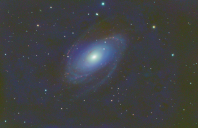Howdy, Stranger!
It looks like you're new here. If you want to get involved, click one of these buttons!
In this Discussion
Blue blotchy background cannot correct out
I have a blue blotchy background with M81 I can't correct out. ZWO 2600MC with Antlia RGB Ultra filter. EDGE 8 at 2032mm without reducer. Image attached is after DBE before anything else, but oversaturated with curves to enhance mottling effect. Does not look like gradient. 3 nights total but same issue with individual nights only. This image from one night set 55 x 5min subs. To try and isolate the issue, I ran WBPP with and without flats, no difference in blue mottling. As expected, no change with ABE vs DBE vs Graxpert, with or without background neutralization. SPCC, PCC or CC does not remove it, as expected. Re-ran WBPP with or without local normalization, no difference. I'm thinking it may be the filter as new to my setup and have never had issue with this on same 2600MC/EDGE combo with more than a dozen targets. If filter though would flats not correct out the error? Any insight appreciated. Thanks. Dieter.


M81_blotchy blue.png
1808 x 1168 - 5M

Comments
So, interesting follow-up findings:
I made new flats with a Photoshop calibrated white background on iPad Pro using initially (for 1 and 2 below) the default ASIAir recommended automatic flat exposure setting:
1. with Antlia RGB filter at ASIAir recommended flat exposure: same extremely widely split channels after delayer seen with original light panel (image 1)
2. without any filter at ASIAir recommended flat exposure: much better RGB channel grouping in mid range (image 2)
3. repeated (with Antlia filter) at half the recommended ASI auto flat exposure (to minimize blue blow-out) and got image 3 after flat field debayer...still wide separation but blue much tamer.
I then applied number 3 as a Masterflat and image processes normally.
My take-home, and feel free if this is wrong conclusion, the Antlia RGB ultra causes a very wide channel split if used with Flat light source that cannot adjust individual channel brightness which leads to blue overexposure if used with ASIAir recommended flat autoexposure.